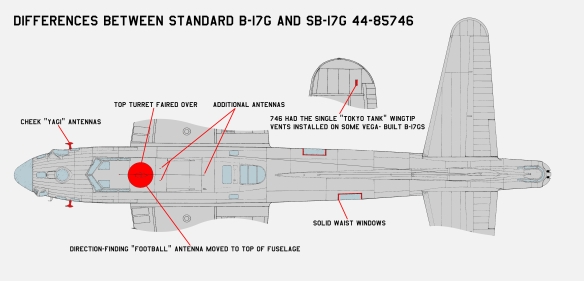The Boeing B-17 was designed as a bomber in 1935, and served very effectively as such through the end of World War II in 1945. Postwar, many B-17s continued to serve in a variety of roles with the newly-formed U.S. Air Force, including target drones (and their respective controllers), research aircraft, Airborne Early Warning, transports, and trainers. Starting in 1944, some B-17s were modified to carry the Higgins A-1 Lifeboat under the fuselage to serve as air-sea rescue aircraft. Designated B-17H, these aircraft served in Europe and the Pacifc. In 1948, the B-17H designation was changed to SB-17G. 130 B-17Gs were converted to B-17H/SB-17G standard and served with the USAAF/USAF, USN, and USCG before the last one was retired in 1956.
The modifications required to bring a B-17G up to SB-17G standards varied depending on the time that the aircraft was modified. All aircraft were modified to carry the A-1 Lifeboat. During WWII, the B-17Hs retained their full crew and armament, but after WWII the bombers’ guns were removed. SB-17Gs serving during the Korean War had their cheek, waist and tail guns put back in place. Most SB-17s had their chin turret removed and replaced with a radome for search radar. Some had their waist windows replaced by single sheets of plexiglas, while others had bulged observation windows put in their place.
746 was built as a standard B-17G, and it is unknown when it was modified to SB-17G standard. The externally visible modifications included:
– All armament was removed, and the top and ball turret openings faired over.
– The chin turret was replaced by the search radar radome.
– Two “Yagi” radar antennas were added to the “cheeks” of the aircraft.
– Several holes were cut in the bomb bay doors to allow the bomber to carry the A-1 lifeboat.
– The “football” direction-finding antenna was relocated to the top of the fuselage.
– Several antenna masts were added to the top of the fuselage.
– The waist gunners’ windows were replaced with solid plexiglas panels.
The images below show the external differences between 746 and a standard B-17G.
Click on the images below to view larger versions.
Another very well-known SB-17G is 44-83575, which served as a TB-17H/SB-17G in Central and South America and the Caribbean from 1945 to 1952. After being used in Atomic bomb tests and serving as an air tanker, it was restored, and is now known as “Nine O Nine.” It is owned by the Collings Foundation, and has been touring the US with their B-24J, B-25J, and P-51C since 1989.
Coming Soon: photos of operational SB-17Gs




